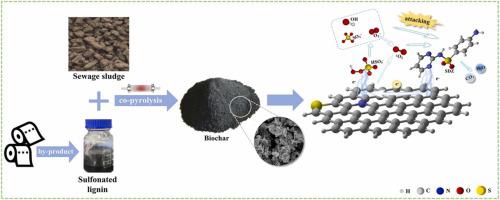当前位置:
X-MOL 学术
›
J. Environ. Chem. Eng.
›
论文详情
Our official English website, www.x-mol.net, welcomes your
feedback! (Note: you will need to create a separate account there.)
Enhanced persulfate activation for sulfadiazine degradation by N, S self-doped biochar from sludge and sulfonated lignin: Emphasizing the roles of graphitic nitrogen and thiophene sulfur
Journal of Environmental Chemical Engineering ( IF 7.4 ) Pub Date : 2024-03-05 , DOI: 10.1016/j.jece.2024.112407 Yuting He , Yuchuan Yang , Xiaoxia Ye , Yuancai Lv , Yifan Liu , Minghua Liu
Journal of Environmental Chemical Engineering ( IF 7.4 ) Pub Date : 2024-03-05 , DOI: 10.1016/j.jece.2024.112407 Yuting He , Yuchuan Yang , Xiaoxia Ye , Yuancai Lv , Yifan Liu , Minghua Liu

|
Biochar derived from sludge is recognized for its sustainable and cost-effective role in advanced oxidation processes, yet its restricted catalytic capacity poses significant challenges. In this work, nitrogen (8.43 at%) and sulfur (1.39 at%) co-doped biochar (ML-SDBC) featuring a large surface area of 161.14 m/g was synthesized by the pyrolysis of sewage sludge and sulfonated lignin without external dopants. In the synthesis of ML-SDBC, graphitic nitrogen and thiophene sulfur were efficiently integsrated into the carbon framework. Furthermore, the resulting biochar notably outperformed sludge-derived biochar (SDBC) in activating peroxymonosulfate (PMS) for sulfadiazine (SDZ) degradation, achieving a 31.9% higher removal rate within 120min and exhibiting a rate constant () of 1.73×10min, effectively tripling the efficiency compared to that of SDBC-driven processes. The degradation rate consistently exceeded 85% across a wide pH range of 3-9. Mechanistic analysis exhibited that degradation processes involved radical and non-radical pathways, with O playing a prominent role. Furthermore, density functional theory (DFT) calculations revealed that the catalytic potential in ML-SDBC would benefit from the synergistic interaction between graphitic nitrogen and thiophene sulfur. This study presents a novel synthesis of heteroatom-doped biochar from waste, offering a sustainable solution to antibiotic pollution and waste management challenges.
中文翻译:

污泥中 N、S 自掺杂生物炭和磺化木质素增强过硫酸盐活化降解磺胺嘧啶:强调石墨氮和噻吩硫的作用
从污泥中提取的生物炭因其在高级氧化过程中可持续且具有成本效益的作用而受到认可,但其有限的催化能力带来了重大挑战。在这项工作中,通过热解污水污泥和磺化木质素,在没有外部掺杂剂的情况下合成了氮(8.43 at%)和硫(1.39 at%)共掺杂生物炭(ML-SDBC),其具有161.14 m / g的大表面积。在ML-SDBC的合成中,石墨氮和噻吩硫被有效地整合到碳骨架中。此外,所得生物炭在活化过一硫酸盐(PMS)以降解磺胺嘧啶(SDZ)方面明显优于污泥衍生生物炭(SDBC),在120分钟内实现了31.9%的去除率,并表现出1.73×10分钟的速率常数(),有效地增加了两倍与 SDBC 驱动流程相比的效率。在 3-9 的广泛 pH 范围内,降解率始终超过 85%。机理分析表明,降解过程涉及自由基和非自由基途径,其中 O 发挥着重要作用。此外,密度泛函理论(DFT)计算表明,ML-SDBC 的催化潜力将受益于石墨氮和噻吩硫之间的协同相互作用。这项研究提出了一种从废物中合成杂原子掺杂生物炭的新方法,为抗生素污染和废物管理挑战提供了可持续的解决方案。
更新日期:2024-03-05
中文翻译:

污泥中 N、S 自掺杂生物炭和磺化木质素增强过硫酸盐活化降解磺胺嘧啶:强调石墨氮和噻吩硫的作用
从污泥中提取的生物炭因其在高级氧化过程中可持续且具有成本效益的作用而受到认可,但其有限的催化能力带来了重大挑战。在这项工作中,通过热解污水污泥和磺化木质素,在没有外部掺杂剂的情况下合成了氮(8.43 at%)和硫(1.39 at%)共掺杂生物炭(ML-SDBC),其具有161.14 m / g的大表面积。在ML-SDBC的合成中,石墨氮和噻吩硫被有效地整合到碳骨架中。此外,所得生物炭在活化过一硫酸盐(PMS)以降解磺胺嘧啶(SDZ)方面明显优于污泥衍生生物炭(SDBC),在120分钟内实现了31.9%的去除率,并表现出1.73×10分钟的速率常数(),有效地增加了两倍与 SDBC 驱动流程相比的效率。在 3-9 的广泛 pH 范围内,降解率始终超过 85%。机理分析表明,降解过程涉及自由基和非自由基途径,其中 O 发挥着重要作用。此外,密度泛函理论(DFT)计算表明,ML-SDBC 的催化潜力将受益于石墨氮和噻吩硫之间的协同相互作用。这项研究提出了一种从废物中合成杂原子掺杂生物炭的新方法,为抗生素污染和废物管理挑战提供了可持续的解决方案。





















































 京公网安备 11010802027423号
京公网安备 11010802027423号